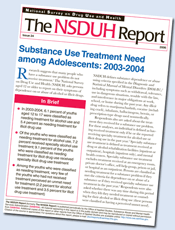Teen Treatment Programs Need Improvement
By Leslie Quander Wooldridge
Adolescents with substance abuse problems require specially
designed treatment programs because they are at vulnerable
stages of developmental change. However, a recent SAMHSA-funded
study of facilities serving significant adolescent populations
indicates that these facilities may not provide comprehensive
services for this group, especially when other co-occurring
illnesses are involved.
 Approximately
2.2 million adolescents (8.9 percent of the total adolescent
population) suffered from alcohol and drug abuse in 2003,
according to SAMHSA’s National Survey on Drug Use
and Health. Approximately
2.2 million adolescents (8.9 percent of the total adolescent
population) suffered from alcohol and drug abuse in 2003,
according to SAMHSA’s National Survey on Drug Use
and Health.
Almost all facilities that treat significant numbers
of children and adolescents for substance abuse conduct
comprehensive substance abuse assessments. However, according
to an article, “Characterizing
Substance Abuse Programs that Treat Adolescents,”
recently published in the Journal of Substance Abuse
Treatment, only half of these facilities also conduct
comprehensive mental health assessments, which are recommended
as part of an integrated treatment approach.
The article was written by researchers from SAMHSA’s
Spending Estimates team, Thomson/Medstat, and SAMHSA
staff.
To determine if treatment centers were following “best
practice” recommendations, researchers compared
data from SAMHSA’s 2003 National Survey of Substance
Abuse Treatment Services (N-SSATS) with nine key quality
elements identified by experts. Best practices, for example,
include use of developmentally appropriate programs and
continuing care for adolescents.
The study found that substance abuse programs with
significant adolescent “volume,” or population,
have “room for improvement” to meet quality
standards.
“On the positive side, results show that facilities
are willing to admit clients with other co-occurring
mental or medical conditions,” said Rita Vandivort,
M.S.W., a public health analyst in the Division of Services
Improvement at SAMHSA’s Center for Substance Abuse
Treatment. “But results also reinforce what many
have already said: that mental health and substance abuse
providers have a way to go to attain truly integrated
treatment.”
Areas needing improvement include mental health, medical
issues in comprehensive assessments, and curricula to
meet the developmental and cultural needs of adolescent
clients.
The study found that only half (50.2 percent) of significant
adolescent-volume facilities offer special programs for
adolescents with co-occurring mental and substance use
disorders. Although the programs provide comprehensive
assessments of substance abuse needs, researchers found
that these programs rarely attend to the mental or other
medical health needs that frequently co-occur with adolescent
substance abuse.
N-SSATS results show that almost all facilities that
treat adolescents are conducting substance abuse assessments
(96.6 percent), but far fewer facilities are conducting
mental health assessments (50 percent), and even fewer
facilities (38.9 percent) are screening for medical conditions
such as HIV.
Although lower rates of mental health assessments and
medical screenings were reported, researchers did find
relatively high rates of other recommended practices
among facilities, specifically discharge planning (84.8
percent), aftercare counseling (82.2 percent), and relapse
prevention groups (84.4 percent).
Researchers found the relatively high rates of these
activities to be encouraging, noting that continuing
care must be improved in order to ensure the “best
possible outcomes” for treatment.
A total of 2,499 significant adolescent-volume facilities
were examined in the study, which was conducted under
the SAMHSA Spending Estimates Project.
For more information, visit SAMHSA’s Web site
at http://csat.samhsa.gov/IDBSE/index.aspx. 
Citation: Mark T.L.,
Song X., Vandivort R., Duffy S., Butler J., Coffey R.,
Shabert V.F. “Characterizing Substance Abuse Programs
that Treat Adolescents.” Journal of Substance
Abuse Treatment, 2006. 31:59–65.
Back to Top
Adolescents and Need for Treatment
 SAMHSA’s
National Survey on Drug Use and Health recently
asked persons age 12 and older to report on their
symptoms of dependence on or abuse of alcohol or
illicit drugs. SAMHSA’s
National Survey on Drug Use and Health recently
asked persons age 12 and older to report on their
symptoms of dependence on or abuse of alcohol or
illicit drugs.
According to the report, Substance
Use Treatment Need among Adolescents: 2003-2004,
about 1.4 million youth (5.4 percent) were classified
as needing treatment for illicit drug use in the
past year.
Data also show that:
Between 2003 and 2004, 6.1 percent of youth age
12 to 17 were classified as needing treatment for
alcohol use. Of the young people classified as needing treatment
for alcohol use, 7.2 percent received specialty
alcohol use treatment. And, 9.1 percent of youth
classified as needing treatment for illicit drug
use received specialty illicit drug use treatment.
For a copy of this report from SAMHSA’s
Office of Applied Studies, visit the SAMHSA Web
site at www.oas.samhsa.gov/2k6/
youthTXneed/youthTXneed.cfm.
For other recent statistical reports, visit www.oas.samhsa.gov. 
|
« Previous
Article
See Also—Next Article »
Back to Top
|




